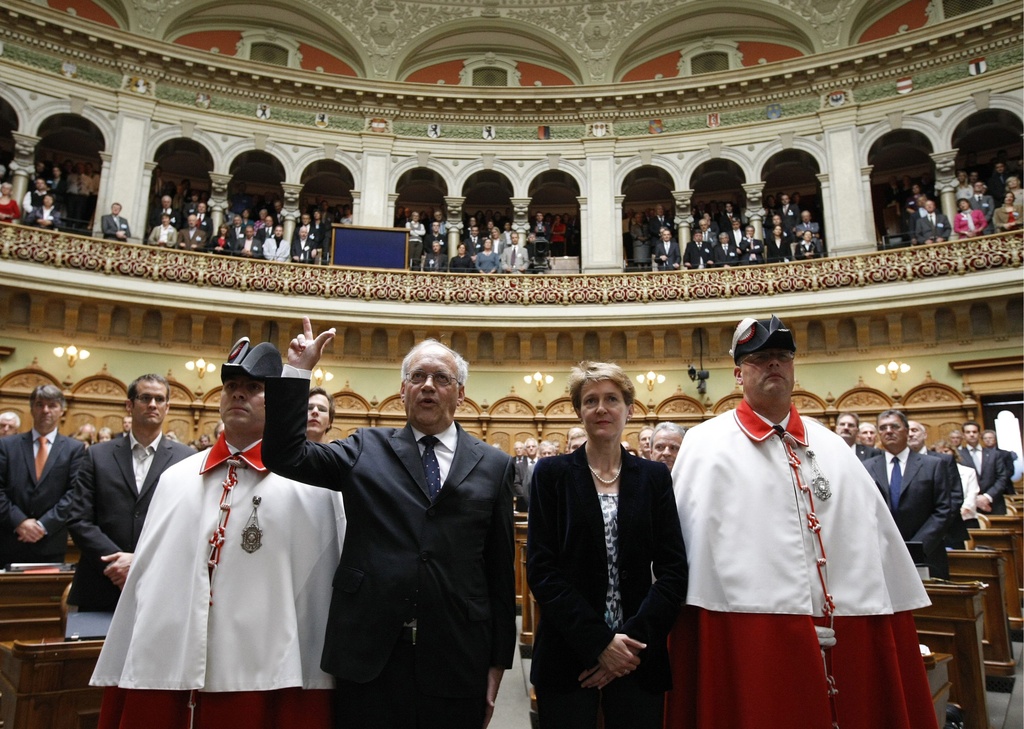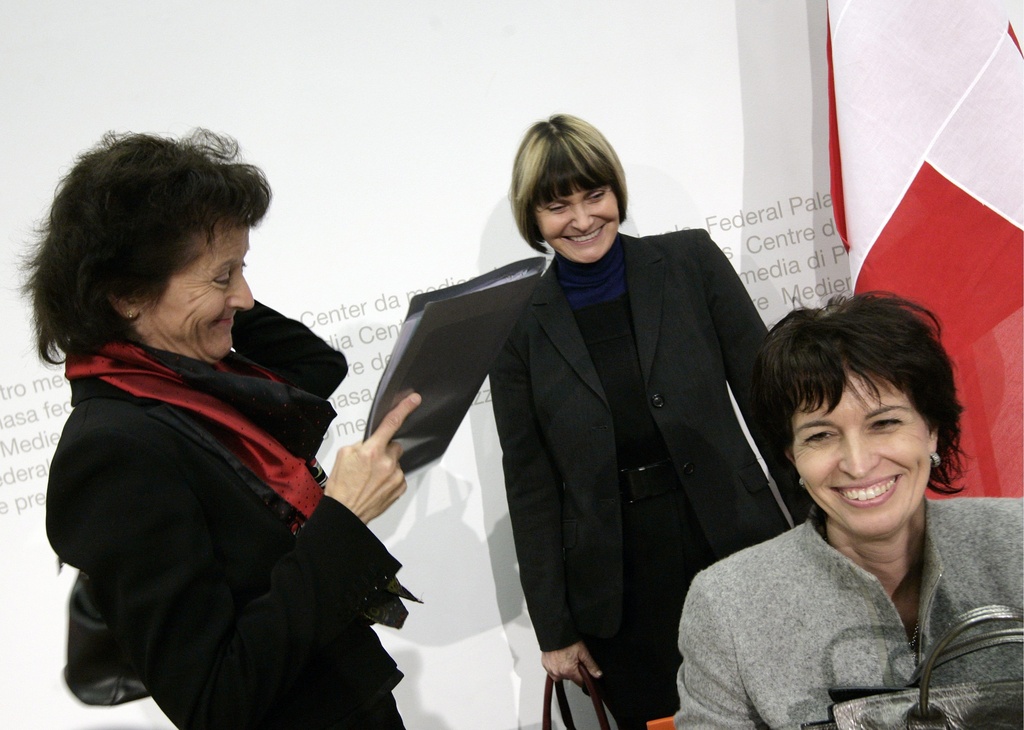Elections produce female majority in cabinet

Simonetta Sommaruga and Johann Schneider-Ammann have been elected to the cabinet, giving modern-day Switzerland its first majority of women ministers.
In the first of Wednesday’s two cabinet appointments, Sommaruga from the centre-left Social Democratic Party replaced party colleague Transport Minister Moritz Leuenberger.
Two hours later, parliamentarians voted, also by secret ballot, to replace Finance Minister Hans-Rudolf Merz from the centre-right Radical Party with party colleague Schneider-Ammann. The cabinet’s political make-up thus stayed the same.
Both outgoing ministers stepped down 14 months before the end of the current four-year term.
In theory parliamentarians could have voted for any member of any party – ignoring the six official candidates.
In the end, however, it took four rounds of voting for Sommaruga to win 159 votes, ahead of Jean-François Rime of the rightwing Swiss People’s Party on 81.
Social Democrat rival Jacqueline Fehr was eliminated in the third round. Rime later also stood for the Radical seat.
“The majority must take into consideration all minorities – be they cultural, linguistic, religious, political or of another nature,” 50-year-old Sommaruga said in her acceptance speech, which she delivered in the country’s four national languages.
Bridge builder
Sommaruga, from Bern, entered the House of Representatives in 1999, moving to the Senate in 2003.
She made a name for herself as head of consumer protection group – which won her huge popularity – and is also known as an expert on economic and finance issues. She is considered excellent at forging alliances across party lines and a tenacious fighter for her convictions.
Her opponents on the other hand find her a distant perfectionist and too liberal for a true Social Democrat.
Sommaruga studied languages and gained a diploma as a concert pianist. She began her political career as a local councillor in Köniz near Bern. She is married to author Lukas Hartmann. They have no children.
Entrepreneur
The second vote followed a similar pattern with Schneider-Ammann needing five rounds to see off Rime. Radical Party rival, Karin Keller-Sutter, was eliminated in the fourth round.
Schneider-Ammann received 144 votes to Rime’s 93.
Schneider-Ammann, 58 and also from Bern, is an entrepreneur and has sat in the House of Representatives as member of the centre-right Radical Party for canton Bern since 1999.
He is said to have excellent ties with the business community. He is head of the engineering association (Swissmem), vice-president of the Swiss Business Federation (economiesuisse) and sits on several top company boards. He has a reputation as a reliable and responsible company boss.
His critics say he is too often away during parliamentary sessions and is an “old-school” politician.
Schneider-Ammann studied electronic engineering at the Federal Institute of Technology in Zurich. He has been chief executive of the Ammann Group for 20 years.
He is married to Katharina Ammann, heiress to the large engineering group in Langenthal. They have two children.
In his acceptance speech, he said in times of uncertainty it was all the more important to have independence, sovereignty and credibility. “We all know that we’re Europeans at the heart of Europe,” he said, backing bilateralism.
Historic vote
The cabinet, made up of seven ministers who share responsibility under a system of collective leadership, now has four women ministers for the first time in its 162-year history. Women only gained the federal right to vote in Switzerland in 1971.
The Social Democrats and the Radicals still have two seats each, while the three remaining posts are shared out among the centre-right Christian Democrats, the Conservative Democrats and the rightwing Swiss People’s Party.
Of the two other official candidates on Wednesday, the challenge of Brigit Wyss of the Green Party was not taken seriously, while the bid of Jean-François Rime was seen as a tactical move by the rightwing to underline their claim for a second seat in cabinet.
The new cabinet will meet on Monday to discuss the portfolios of the new members. Rumours of a cabinet reshuffle have been rife, with speculation Economics Minister Doris Leuthard could take over the complex transport ministry which includes also energy, environment and communications.
swissinfo.ch
The Swiss government consists of a cabinet made up of seven members.
There is no prime minister. The position of president rotates among cabinet ministers every year.
The cabinet should reflect the political, cultural and linguistic diversity of the country.
For 50 years cabinet posts were shared out among the four main parties – the Radicals, the Christian Democrats, the Social Democrats and the Swiss People’s Party – under an informal agreement.
The system known as the Magic Formula was thrown out in 2003.
A fundamental tenet of the multiparty cabinet is the need to reach consensus and that decisions are taken collectively.
Cabinet members are nominated by their parties, and are elected at a joint session of the two chambers of parliament.
The ballot is secret.
A candidate needs at least 50% plus one vote of valid ballot sheets to be elected.
The seven cabinet members have to be confirmed in their posts every four years in the wake of parliamentary elections due in October 2011.

In compliance with the JTI standards
More: SWI swissinfo.ch certified by the Journalism Trust Initiative














You can find an overview of ongoing debates with our journalists here . Please join us!
If you want to start a conversation about a topic raised in this article or want to report factual errors, email us at english@swissinfo.ch.